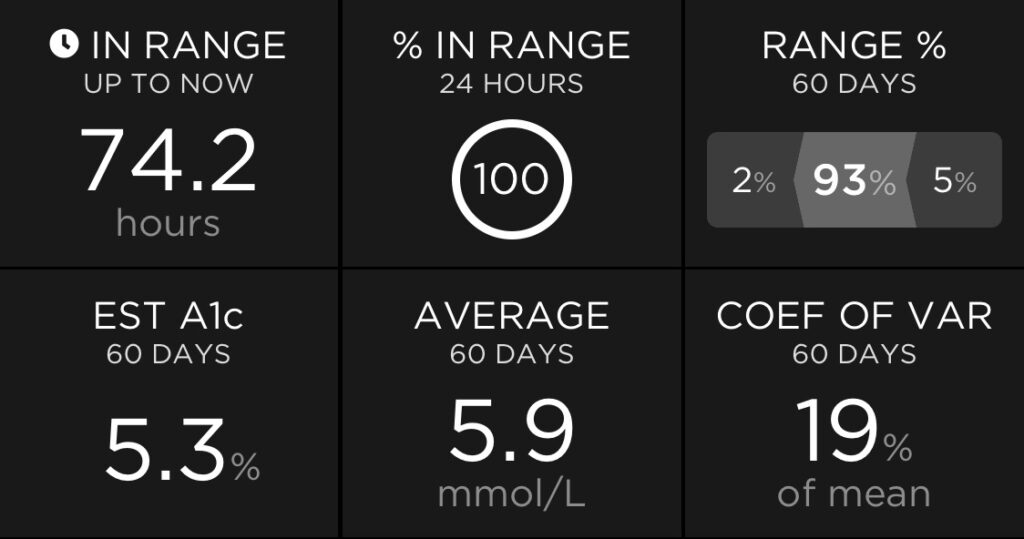Time In Range (TIR) is one of the popular (and useful!) metrics we get from our CGM data. What percentage of time have we been spending “between the flags” of our defined range. Most CGM reporting software will display this today.
 For example Dexcom’s Clarity app displays it as a graph, with the traditional “green” as in-range. We do always have to be conscious of which range is being used, and luckily here it’s displayed prominently. I’ve written in the past about selections of goal ranges.
For example Dexcom’s Clarity app displays it as a graph, with the traditional “green” as in-range. We do always have to be conscious of which range is being used, and luckily here it’s displayed prominently. I’ve written in the past about selections of goal ranges.
Today I mostly analyse my own data against 3.9-7.8 mmol/L (70-140 mg/dL). But whatever we use, we should be consistent (and not try to compare TIR with those of other ranges).
 Happy Bob concentrates on this with its star rating system, although it uses pre-defined ranges and ticks over at midnight every day.
Happy Bob concentrates on this with its star rating system, although it uses pre-defined ranges and ticks over at midnight every day.
Bob gives two stars for each sample within 4.0-7.0, and one star for every sample between 7.1-10.0. A maximum of 576 stars by midnight.
The goal of staying In-Range
Being in-range is good. The less time we spend toward hypo or hyper territory, the better for our bodies it is. I think the main thing that might count against a super-high percentage TIR might be if it comes at a huge mental cost (e.g. continually having to fine-tune and tweak things, affecting your quality of life).
Obviously, we get a higher percentage the longer we spend in range, but it’s usually not reasonable to assume we’ll stay within range 100% of every day. Unless we set the range artificially wide of course!
But occasionally we do sometimes get a day of 100%, and it tends to be a cause of wonderment and amazement!
If we’re doing well we might get a second day, but eventually we are going to drop out.

Sugarmate plays into this, with the ability to prominently display how many hours you have been in range so far. In this example you can see I’d been in range for a massive 74 hours (over 3 days) at this point!
However as soon as you get one reading 0.1 mmol/L out of range (even if it immediately drops back into range) that counter has started at zero again. Thankfully the time in range statistic would hardly notice that little blip, and might even still round out to 100%. But we lose that “streak counter”.
Streaks can be good AND bad!
It’s great to be able to have a streak running that long. Unfortunately all good things come to an end.
It’s very important to not see this as a failure. Sure, it was wonderful for me to be able to stay within range for 3 days, but the fact that I dropped out of range soon after does not detract from the overall health benefits of staying in range most of the time.
I hope you don’t fall into the trap of being disappointed/frustrated with yourself when a streak comes to an end. It’s the overall percentage of time in range that’s important. For the 5-day period shown at the very top of this article, the overall TIR was 98.7%, which I was very happy with. Keeping it at 100% forever would be asking a lot of yourself!
As discussed in my article about goal ranges, when I started to get long stretches of being in-range with 3.9-10.0, I did take that as encouragement to narrow my range slightly (at first I dropped it to 3.9-9.0). But that was a “looser” judgement: a “feeling” that I was getting multiple days (not necessarily in a row) of 100%.

